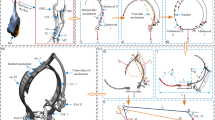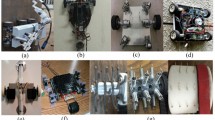Abstract
The rapid development of space technology has made it increasingly important to use space robots for on-orbit services. Space crawling robots can perform extravehicular condition monitoring, spacecraft fault location and diagnosis, repair and maintenance by carrying different payloads and traversing the spacecraft surface, which has received wide attention from researchers. A prototype of space crawling robot has been designed in this work, which is a quadrupedal insect-like configuration with integrated bionic adhesion material on the bottom of the four feet, and can walk on the satellite surface in a gravity-free space environment. The design and implementation of the crawling robot control system is carried out based on Robot Operating System, including hardware system construction and software architecture design. The tripod gait was also designed to enable the robot to crawl more stably in space. At last, the basic capabilities of the designed space crawling robot are tested in the ground environment, and the results demonstrate the robot’s body control capability, omnidirectional walking capability, and obstacle crossing and avoidance capability.










Similar content being viewed by others
References
Li W, Cheng D, Liu X, Wang Y, Shi W, Tang Z et al (2019) On-orbit service (OOS) of spacecraft: a review of engineering developments. Prog Aerosp Sci 108:32–120
Flores-Abad A, Ou M, Pham K, Ulrich S (2014) A review of space robotics technologies for on-orbit servicing. Prog Aerosp Sci 68:1–26
Autumn K, Liang YA, Hsieh ST, Zesch W, Chan WP, Kenny TW et al (2000) Adhesive force of a single gecko foot-hair. Nature 405:681–685
Wang W, Liu Y, Xie Z (2021) Gecko-like dry adhesive surfaces and their applications: a review. J Bionic Eng. https://doi.org/10.1007/s42235-021-00088-7
Jiang H, Hawkes E, Fuller C, Estrada M, Suresh S, Abcouwer N et al (2017) A robotic device using gecko-inspired adhesives can grasp and manipulate large objects in microgravity. Sci Robot 2:4545
Murphy MP, Sitti M (2007) Waalbot: an agile small-scale wall-climbing robot utilizing dry elastomer adhesives. IEEE/ASME Trans Mechatron 12:330–338
Murphy MP, Kute C, Menguec Y, Sitti M (2011) Waalbot II: adhesion recovery and improved performance of a climbing robot using fibrillar adhesives. Int J Robot Res 30:118–133
Seo T, Sitti M (2013) Tank-like module-based climbing robot using passive compliant joints. In: Mechatronics IEEE/ASME transactions on
Unver O, Sitti M (2010) Tankbot: a palm-size, tank-like climbing robot using soft elastomer adhesive treads. Int J Robot Res 29:1761–1777
Henrey M, Ahmed A, Boscariol P, Shannon L, Menon C (2014) Abigaille-III: a versatile, bioinspired hexapod for scaling smooth vertical surfaces. J Bionic Eng 11:1–17
Li Y, Ahmed A, Dan S, Menon C (2012) Abigaille II: toward the development of a spider-inspired climbing robot. Robotica 30:79–89
Wall-crawling gecko robots can stick in space too (2014). https://www.esa.int/Enabling_Support/Space_Engineering_Technology/Wall-crawling_gecko_robots_can_stick_in_space_too. Accessed 26 Aug 2021.
Wang Z, Lu X, Liu Q, Song Y, Dai Z (2017) Adhesion performance test and trajectory optimization for gecko-inspired footpad under simulated micro-gravity environment. Chin Sci Bull 62(19):2149–2156
Ye Y, Zhang Y, Huang H, Fan G, Huo M, Qi N (2017) The design and analysis of the biomimetic adherent inchworm-like robot. J Aerosp Sci Technol 05:194–211
Liu Y, Lim B, Lee JW, Park J, Kim T, Seo T (2020) Steerable dry-adhesive linkage-type wall-climbing robot. Mech Mach Theory 153:103987
Bian S, Wei Y, Xu F, Kong D (2021) A four-legged wall-climbing robot with spines and miniature setae array inspired by longicorn and gecko. J Bionic Eng 18:292–305
Author information
Authors and Affiliations
Corresponding author
Ethics declarations
Conflict of Interest
On behalf of all authors, the corresponding author states that there is no conflict of interest.
Rights and permissions
About this article
Cite this article
Xie, Z., Chen, X., Chen, D. et al. Initial Design and Implementation of a Space Quadruped Crawling Robot Prototype. Adv. Astronaut. Sci. Technol. 4, 173–181 (2021). https://doi.org/10.1007/s42423-021-00090-5
Received:
Revised:
Accepted:
Published:
Issue Date:
DOI: https://doi.org/10.1007/s42423-021-00090-5




